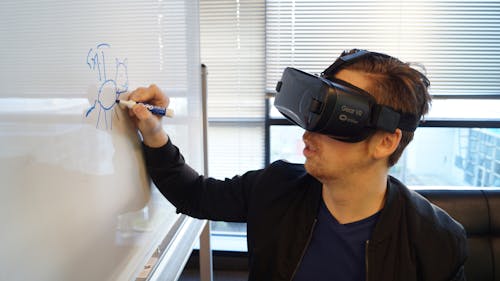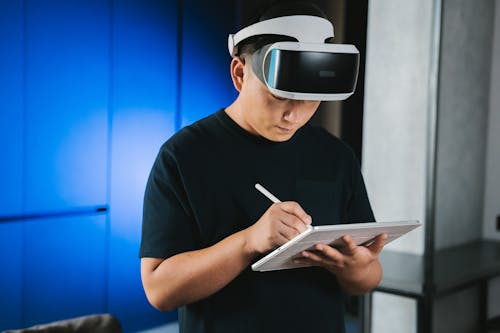The Growing Influence of Virtual Reality in Learning
Over the past decade, Virtual Reality (VR) has transcended the world of gaming and entertainment, entering sectors that rely heavily on learning, skill development, and training. In education and professional training environments, VR is not just a novel tool—it is rapidly becoming a transformative force. As technology continues to evolve, VR offers immersive, interactive experiences that go far beyond traditional methods of teaching and learning. This shift is particularly evident in the way students and professionals engage with educational content, practice skills, and experience situations that would otherwise be difficult or impossible in the real world.
From classrooms to corporate training rooms, VR is changing the way knowledge is delivered and absorbed. But what makes VR so powerful, and how is it reshaping education and training for the better? Let’s delve into how this immersive technology is impacting learning environments and skills development.
Immersive Learning: A New Dimension in Education

Traditional teaching methods often rely on textbooks, lectures, and physical demonstrations to convey knowledge. While these methods can be effective, they are limited in their ability to provide students with direct experiences or real-world applications. Virtual Reality solves this by providing an immersive environment where learners can actively engage with educational content in ways that were once unimaginable.
In VR, students can enter simulations that place them in real-world scenarios. For example, medical students can practice surgery in a risk-free virtual operating room, allowing them to build practical skills and understanding without the pressure of performing on actual patients. In history classes, students can “visit” ancient civilizations or historical events, gaining a deeper understanding of the subject through firsthand virtual experiences.
This type of immersive learning has been shown to increase student engagement, retention, and understanding of complex topics. Unlike passive learning, where students absorb information without active participation, VR allows learners to interact directly with content, leading to enhanced problem-solving and critical thinking.
Bridging the Gap Between Theory and Practice
One of the most significant benefits of VR in education and training is its ability to bridge the gap between theoretical knowledge and practical application. Many fields require hands-on experience to master, but the resources or environments necessary for practice can be scarce, expensive, or dangerous. VR offers a safe, cost-effective solution to this problem by enabling students and professionals to simulate real-world scenarios.
In fields such as aviation, engineering, and military training, VR provides a platform for learners to practice high-risk activities without the associated dangers. Flight simulators have long been used in pilot training, but VR takes this to a new level by providing a fully immersive, interactive experience. Trainees can practice in virtual cockpits, responding to various flight conditions and emergencies, all without ever leaving the ground.
Similarly, VR is used in training healthcare professionals, such as doctors, nurses, and emergency responders, to prepare for critical situations. VR simulations of medical procedures or emergency response situations provide a controlled environment where learners can practice skills, make decisions, and correct mistakes in real time, all without any physical consequences.
Personalized Learning Experiences
Virtual Reality also offers the advantage of creating personalized learning experiences. In traditional classroom settings, the pace of learning is often dictated by the teacher or curriculum, leaving some students ahead and others behind. With VR, learners can progress at their own pace, repeating scenarios or exercises until they feel confident in their skills. This personalized approach allows for more tailored learning paths, enabling individuals to focus on their specific areas of need.
For example, in language learning, VR can immerse students in virtual environments where they interact with native speakers, allowing them to practice conversations in realistic settings. This approach is far more engaging than traditional textbook exercises and offers a level of immersion that helps learners pick up language skills more naturally.
Engaging Remote Learners and Expanding Access
One of the most exciting aspects of VR in education is its ability to bring learning experiences to remote or underserved populations. With VR, geographical location becomes less of a barrier to education, as students around the world can access immersive learning opportunities without the need to be physically present in a classroom or training facility.
For individuals in rural areas or countries with limited educational resources, VR opens up new possibilities for higher-quality education. Students can visit virtual classrooms, attend seminars, or participate in live training sessions from anywhere, effectively bridging the digital divide and providing equal access to high-level learning experiences.
Moreover, VR can facilitate collaboration between remote teams. Professionals in different parts of the world can interact in virtual environments, attend training sessions together, and work on projects in real-time, regardless of their physical location. This capability is especially beneficial for global organizations that need to provide training across multiple locations, helping to standardize learning across the board.
Revolutionizing Corporate Training
In the corporate world, VR is becoming a powerful tool for training employees across various industries. Traditional methods of corporate training—such as workshops, eLearning, and in-person seminars—are often time-consuming and expensive. VR offers a more efficient and engaging alternative, allowing employees to gain experience in simulated work environments that closely mirror real-world challenges.

From customer service training to leadership development, VR enables employees to practice and refine their skills in a variety of scenarios. In retail, VR can simulate customer interactions, allowing sales associates to practice handling difficult situations, answering questions, and providing assistance. Similarly, VR can be used in industries like manufacturing, where workers can practice operating machinery, navigating safety protocols, and troubleshooting problems without the risk of accidents or expensive downtime.
The ability to immerse employees in realistic training scenarios helps improve performance, retention, and problem-solving abilities. Moreover, VR training can be conducted at scale, making it easier for organizations to train large numbers of employees consistently and cost-effectively.
Creating Safe Spaces for Trial and Error
One of the key advantages of using VR for training and education is the ability to create a safe space where learners can make mistakes without real-world consequences. In traditional training settings, errors can lead to costly or dangerous outcomes, especially in fields such as healthcare, aviation, and engineering. With VR, learners can experiment, fail, and learn from their mistakes in a controlled environment, enhancing their overall skill development and confidence.
For example, in medical education, VR allows students to perform surgeries or diagnose patients without the risks associated with practicing on real patients. Similarly, in law enforcement or military training, VR simulations can present high-stress situations, giving officers or soldiers the chance to practice making decisions in real time without the fear of real-world repercussions.
This approach to learning encourages a growth mindset, where mistakes are seen as opportunities to learn rather than failures to avoid. It also allows learners to repeat exercises as many times as necessary to master new skills, increasing proficiency and competence in their field.
The Future of VR in Education and Training
As VR technology continues to improve, its potential in education and training is limitless. Advances in hardware, software, and interactivity will make virtual environments even more realistic, enabling even deeper immersion and engagement. In the future, we can expect VR to become even more integral to educational systems, not just as a tool for supplementary learning but as a core component of how students and professionals gain knowledge and experience.
Moreover, with the rise of AI and machine learning, VR can be further personalized, adapting learning environments based on the unique needs and progress of each learner. This will lead to even more tailored and efficient educational experiences.
Conclusion
Virtual Reality is no longer a futuristic concept—it’s here and transforming education and training as we know it. By offering immersive, interactive, and safe environments for learning, VR is providing new opportunities for both students and professionals across a wide range of fields. As this technology continues to evolve, we can expect it to play an even more significant role in shaping how we learn, work, and grow in the years to come. Whether it’s preparing medical students for surgery, training corporate employees, or helping remote learners access education, VR is opening doors to new possibilities in education and training.





